Click above for a high-res gallery of the 2009 Chevrolet Corvette ZR1
Last week, General Motors' Bowling Green, KY assembly plant began manufacturing the fastest, most powerful production Corvette in its 55-year history. We got our first official look at the 2009 Corvette ZR1 at the Detroit Auto Show in January and, at that time, Chevrolet officials hadn't finalized the numbers. Over the intervening months, GM continued to tease us with bits of information, including the ZR1's 205 mph top speed, 638 horsepower, 605 lb.-ft. of torque, and 7:26.4 lap time at the Nurburgring. Throughout all of this, we've been waiting patiently for one of the most anticipated invitations of 2008: the ZR1 First Drive.
That wait finally ended a few weeks ago when we got the call to arrive at GM's Milford Proving Grounds. All we needed was cooperative weather. As the sun crested the horizon on the appointed day, the darkened skies threatened to put the kibosh on our time with the King. But a few hours later, the clouds dissipated and the fun was officially underway.
UPDATE: Video of Corvette ZR1 on the Lutz Ring added after the jump.
Last week, General Motors' Bowling Green, KY assembly plant began manufacturing the fastest, most powerful production Corvette in its 55-year history. We got our first official look at the 2009 Corvette ZR1 at the Detroit Auto Show in January and, at that time, Chevrolet officials hadn't finalized the numbers. Over the intervening months, GM continued to tease us with bits of information, including the ZR1's 205 mph top speed, 638 horsepower, 605 lb.-ft. of torque, and 7:26.4 lap time at the Nurburgring. Throughout all of this, we've been waiting patiently for one of the most anticipated invitations of 2008: the ZR1 First Drive.
That wait finally ended a few weeks ago when we got the call to arrive at GM's Milford Proving Grounds. All we needed was cooperative weather. As the sun crested the horizon on the appointed day, the darkened skies threatened to put the kibosh on our time with the King. But a few hours later, the clouds dissipated and the fun was officially underway.
UPDATE: Video of Corvette ZR1 on the Lutz Ring added after the jump.
Photos Copyright ©2008 Chris Shunk / Sam Abuelsamid / Weblogs, Inc.
Boy, what a difference a year makes. Twelve months ago I was working full time as an engineer for an automotive supplier, and in the course of that work spent a significant amount of time working with prototype vehicles at the Milford Proving Grounds. At the time, we had all seen spy photos of the new 'Vette and most people were still referring to it as the SS or Blue Devil. Of course, anything I personally saw in the course of my job was off-limits for discussion or publication. I didn't actually know any details about the new super-Vette, but could hear the monster and glorious sound it made while running around Milford.
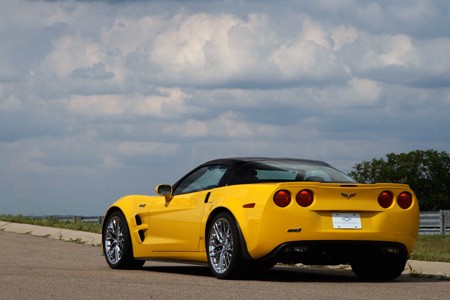
There were two main places I saw the ZR1 working out: the East-West straightaway where the development cars were doing acceleration and braking tests and the "Lutz-Ring". In the process of testing some low speed braking behavior, I used a storage parking lot that sits within the road course that Bob built because it's one of the few places on the grounds with smooth pavement. While analyzing data on more than one occasion, I saw the ZR1 heading out on the road course to get its daily exercise.
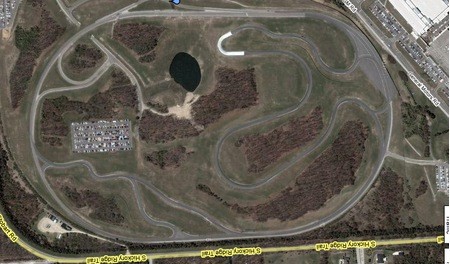
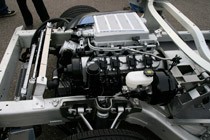
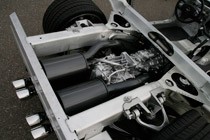
Since safety is a paramount concern at test tracks, facilities like the Milford Road Course are typically off-limits without special permission from the safety department. Unfortunately, I never had the opportunity to actually drive the road course as part of my old job. When the call came to drive the ZR1 on the road course, I had to jump at it. The track is nick-named the Lutz-Ring because GM's Vice Chairman was largely responsible for its existence. Within the outer oval is an array of corners and terrain that replicates portions of famous race tracks, including the steeply banked "Toilet Bowl" from Watkins Glen. For our drive, the traffic safety crew coned off certain sections and added a chicane in the back straight in order to keep speeds under control. Nonetheless, we were able to get a pretty good feel for the immense performance of which the new ZR1 is capable.
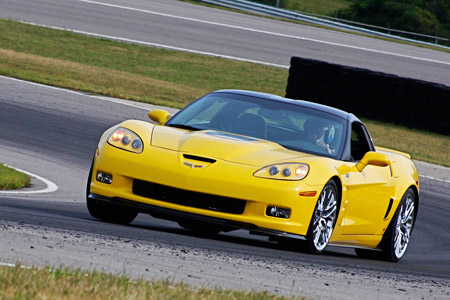
Most of what was said in the pre-drive briefing repeated what we heard back in December and January, and we've written at length about both the car and its new supercharged LS9 V8. We did get a few new tidbits of new information, including that all 2009 Corvettes are getting an updated Bosch stability control system, as well as a new variable ratio steering system. Both the Z06 and ZR1 get a larger 10.5-quart dry sump oil system this year, as well. A less expensive 1LT trim level has been added for the Corvette Convertible, so the open top 'Vette is now available for only $5,000 more than the base coupe, while the '09 Z06 gets a new wheel design.
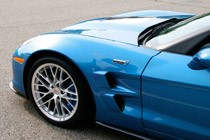
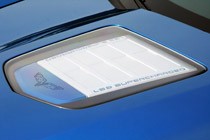
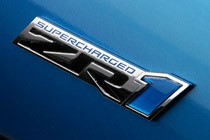
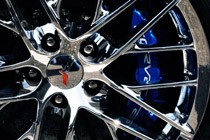
But you don't really care about those lesser 'Vettes, do you? You want to know how the ZR1 drives. Well it's not bad, not bad at all. In fact, it's amazing. There was a time not so long ago that getting 638 hp out of an engine meant using enormous carburetors and camshafts with insane lift and timing. However, those engines didn't like to idle below 1,500 rpm, weren't very tractable and exhibited undesirable characteristics like vapor lock in hot weather. The miracle of modern electronic engine management means all those problems are history. It's now possible to have a car that can top 200 mph and get to 60 mph in the low 3-second range while being utterly tractable and easy drive on a daily basis.
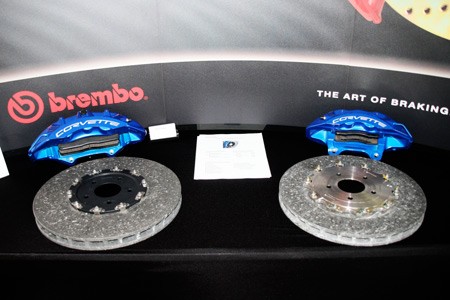
We split in two groups when the time came to drive, with our group heading out on an open road loop with a pair of ZR1s, a Z06 and a few base Vettes in coupe and convertible form. We grabbed one of the ZR1s for the first leg, and the first thing we noticed was the absence of any drama with the brakes. The ZR1 is equipped with massive 15.5-inch carbon-ceramic rotors in front with six-piston mono-block calipers. The rear axle has mere 15-inch rotors with four-pot calipers. Carbon-ceramic brakes used on race cars have incredible fade resistance, but very little friction before they heat up. This clearly isn't appropriate for a road car, so Italian brake supplier Brembo has formulated these new carbon-ceramic brakes to provide immense stopping power even when cold. They succeeded.
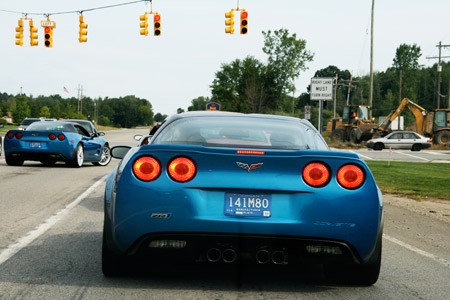
You might think that a car with 30-series tires on the front and 25-series rubber in the back might have issues with ride comfort, but that wasn't the case either. The new, second generation magneto-rheological (MR) dampers have allowed engineers to achieve much of what they were trying to get from full active suspension systems in the late '80s and early '90s at a much lower cost and power consumption. The ZR1 is as comfortable over Michigan roads as the base Corvette, but the MR system allows it be instantly transformed on the track. While this is no Lexus, compared to a C4 Corvette like the original ZR-1, this new coupe is positively luxurious.
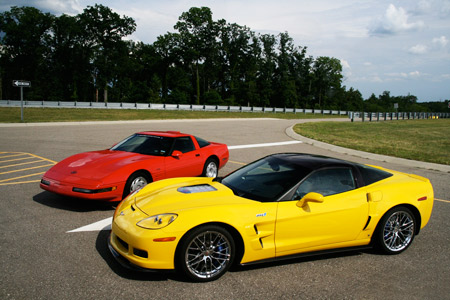
For anyone who's heard the thunderous roar of one of the C6R Corvettes that run in the 24 Hours of Le Mans or American Le Mans Series, the ZR1's bark at wide open throttle will be immediately familiar. The first time I heard a ZR1 doing acceleration runs last summer, I couldn't believe this was a production car. When driving at highway speeds, you normally don't hear the exhaust note of other cars. But when we were following a ZR1 up US-23 and the driver floored it, the dual mode exhaust opened up and you could almost feel the sound waves as it pulled away.

During the initial backgrounder last December, Chief Engineer Tadge Juechter explained that the team wanted to create a Corvette with supercar performance that was livable for everyday use. Many reviewers have complained that the Z06 is just too twitchy and hard to live with. We didn't spend a lot of time in the ZR1 on the road, but first impressions proved that the uber-'Vette is actually more comfortable for daily use than its little brother.
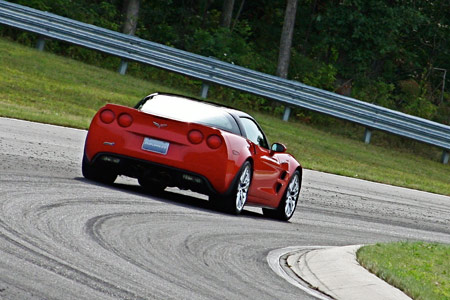
When we returned to Milford, it was time to hit the Lutz-Ring. After a couple of orientation laps of the track in Tahoe hybrids, we grabbed some helmets and hopped into the cars. Three ZR1s were available in black, yellow and red. Just to make sure we stayed safe and didn't get too overconfident on the track, the safety crew made us come back into the pits at the end of every lap. After a moderate reconnaissance lap, it was time to gradually turn up the wick. One thing became immediately clear both on the road and the track. Unlike most engines, the ZR1 doesn't really have a torque curve. It's more like an electric motor -- massive torque is everywhere. In fact, it has so much twist you almost don't need shift. Put the gear lever in third and roll on the throttle until you've accumulated enough speed as your license can tolerate and then lay on the brakes as hard as you please.
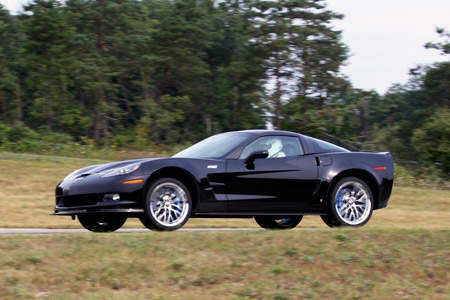
The supercharged LS9 is unbelievably tractable with never a hiccup or shudder. At idle, it ticks over gently with just enough vibration to let you know it's alive and a muted rumble from the exhaust. Squeeze the throttle gently, let out the clutch and it pulls away smoothly without any chattering or lurching. For a car with this much torque, the clutch effort is remarkably light thanks to the dual plate set up. As we became familiar with the track, we started pushing the ZR1 a little harder each lap. We made sure not to light up the rears in front of the safety chief while accelerating down the entrance ramp from the pits, but were still hitting nearly 90 before braking for the first turn.
The video meant to be presented here is no longer available. Sorry for the inconvenience.
We gradually took the corners faster until we could feel the car starting to slide, but the ZR1 never felt like it was going to snap on us. It was just totally progressive breakaway. The Michelin Pilot Sport 2 tires didn't make much noticeable noise, at least compared to the LS9 engine, but we could feel them gradually releasing their grip as they went above and beyond their slip curve. Just like the flat, continuous torque of the engine, the grip of the tires hangs on and never seems to completely go away. Some of this was clearly due to the stability control, which kept things under control without ever really seeming to be active. With the stability control switched to Competition mode, the back end slid out further, but again, it was progressive without doing anything sudden.
On the track, we weren't allowed to stretch the ZR1's legs beyond fourth gear. On the back side of the track, there were a set of esses that emptied out into a sweeping right hander that climbs uphill back to the pits. We grabbed third gear coming out the last of the esses and accelerated hard up toward the pits getting to fourth before braking hard to exit the track. The brakes are phenomenal at speed -- always predictable and confidence inspiring, and they never exhibited even the slightest hint of fade.
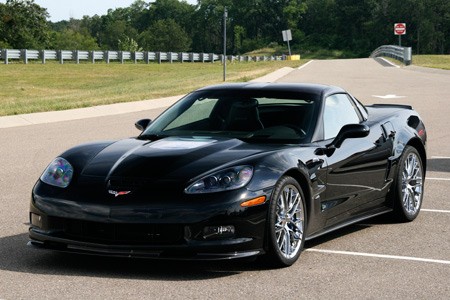
The ZR1 may well be the best supercar bargain in the world, while at the same time being as mechanically sophisticated as any of the best supercars from Europe or Asia. People have complained that an engine based on the half-century old small block V8 is a travesty in the 21st century. Those people don't have a leg to stand on. The LS9 may share basic dimensions and architecture with a 1955 Chevy V8, but it has no common parts and has nothing to be ashamed of. GM's engineers have done a brilliant job of packaging the LS9 and unlike the early '90s C4-based ZR-1, this one has a solid structure that doesn't shake and rattle.
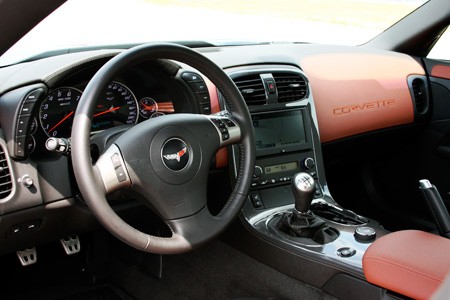
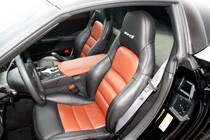
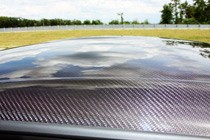
With the premium equipment package covering the interior in cut-and-sew leather, the ZR1 is actually a pretty decent place to spend some time. We have only one complaint about the ZR1 interior and that's its seats. While the thrones are comfortable, they need more lateral support for a car with this kind of performance. That's a relatively small complaint all things considered, and with a base price of $105,000 including delivery and gas-guzzler taxes, plus another $10,000 for the premium package, the ZR1 blows away nearly everything else in the bang for your buck category. Now we just need one in the Autoblog Garage.
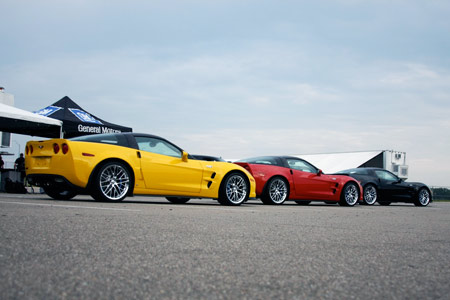
Related:
Photos Copyright ©2008 Chris Shunk / Sam Abuelsamid / Weblogs, Inc.
The video meant to be presented here is no longer available. Sorry for the inconvenience.

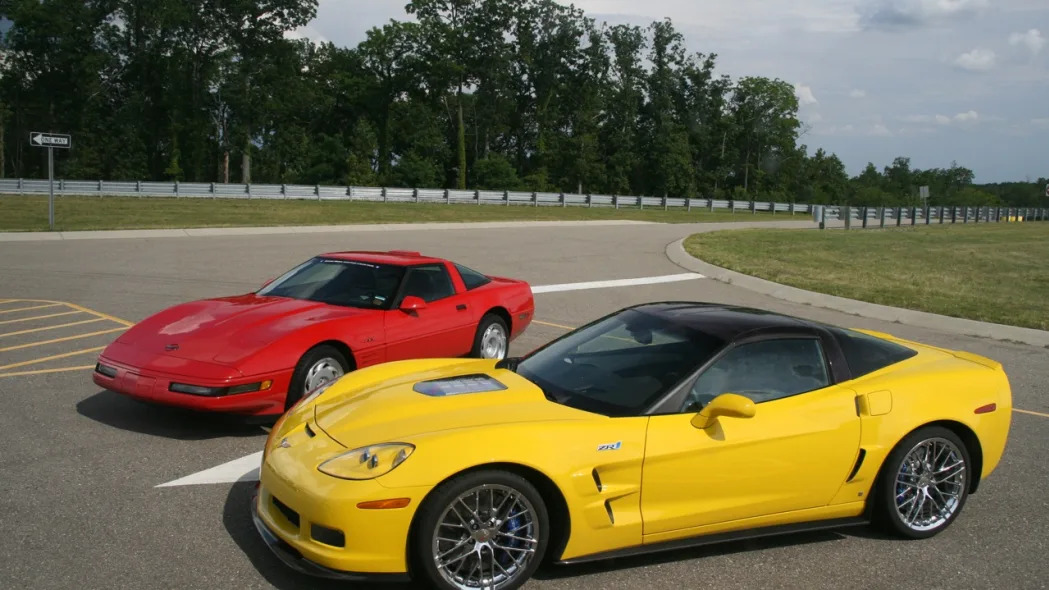

Sign in to post
Please sign in to leave a comment.
Continue